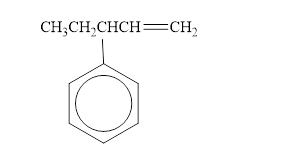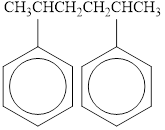
Chemistry for Today: General Organic and Biochemistry
9th Edition
ISBN: 9781337514576
Author: Seager
Publisher: Cengage
expand_more
expand_more
format_list_bulleted
Concept explainers
Textbook Question
Chapter 12, Problem 12.54E
Give an IUPAC name for the following as hydrocarbons with the benzene ring as a substituent:
a. 
b. 
Expert Solution & Answer
Trending nowThis is a popular solution!

Students have asked these similar questions
None
3.
A molecular form of "dicarbon", C2, can be generated in gas phase. Its bond dissociation
energy has been determined at 599 kJ/mol. Use molecular orbital theory to explain why energy
of dissociation for C₂+ is 513 kJ/mol, and that for C2² is 818 kJ/mol. (10 points)
9.73 g of lead(IV) chloride contains enough Cl- ions to make ____ g of magnesium chloride.
Chapter 12 Solutions
Chemistry for Today: General Organic and Biochemistry
Ch. 12 - Prob. 12.1ECh. 12 - Define the terms alkene, alkyne, and aromatic...Ch. 12 - Select those compounds that can be correctly...Ch. 12 - Prob. 12.4ECh. 12 - Give the IUPAC name for the following compounds:...Ch. 12 - Prob. 12.6ECh. 12 - Prob. 12.7ECh. 12 - Prob. 12.8ECh. 12 - Prob. 12.9ECh. 12 - Prob. 12.10E
Ch. 12 - Prob. 12.11ECh. 12 - Prob. 12.12ECh. 12 - What type of hybridized orbital is present on...Ch. 12 - What type of orbital overlaps to form a pi bond in...Ch. 12 - Prob. 12.15ECh. 12 - Explain the difference between geometric and...Ch. 12 - Draw structural formulas and give IUPAC names for...Ch. 12 - Prob. 12.18ECh. 12 - Which of the following alkenes can exist as...Ch. 12 - Draw structural formulas for the following:...Ch. 12 - Prob. 12.21ECh. 12 - In what ways are the physical properties of...Ch. 12 - Prob. 12.23ECh. 12 - Prob. 12.24ECh. 12 - Complete the following reactions. Where more than...Ch. 12 - Prob. 12.26ECh. 12 - Prob. 12.27ECh. 12 - What reagents would you use to prepare each of the...Ch. 12 - What is an important commercial application of...Ch. 12 - Prob. 12.30ECh. 12 - Terpin hydrate is used medicinally as an...Ch. 12 - Prob. 12.32ECh. 12 - Prob. 12.33ECh. 12 - Prob. 12.34ECh. 12 - Prob. 12.35ECh. 12 - Much of todays plumbing in newly built homes is...Ch. 12 - Prob. 12.37ECh. 12 - What type of hybridized orbital is present on...Ch. 12 - How many sigma bonds and how many pi bonds make up...Ch. 12 - Prob. 12.40ECh. 12 - Explain why geometric isomerism is not possible in...Ch. 12 - Give the common name and major uses of the...Ch. 12 - Describe the physical and chemical properties of...Ch. 12 - Prob. 12.44ECh. 12 - Prob. 12.45ECh. 12 - Prob. 12.46ECh. 12 - Prob. 12.47ECh. 12 - Prob. 12.48ECh. 12 - Limonene, which is present in citrus peelings, has...Ch. 12 - A disubstituted cycloalkane such as a exhibits...Ch. 12 - Prob. 12.51ECh. 12 - Prob. 12.52ECh. 12 - Give an IUPAC name for the following as...Ch. 12 - Give an IUPAC name for the following as...Ch. 12 - Name the following compounds, using the prefixed...Ch. 12 - Name the following compounds, using the prefixed...Ch. 12 - Name the following by numbering the benzene ring....Ch. 12 - Name the following by numbering the benzene ring....Ch. 12 - Prob. 12.59ECh. 12 - Write structural formulas for the following:...Ch. 12 - Prob. 12.61ECh. 12 - Prob. 12.62ECh. 12 - Prob. 12.63ECh. 12 - Prob. 12.64ECh. 12 - Prob. 12.65ECh. 12 - Prob. 12.66ECh. 12 - Prob. 12.67ECh. 12 - Prob. 12.68ECh. 12 - Prob. 12.69ECh. 12 - Prob. 12.70ECh. 12 - Prob. 12.71ECh. 12 - Prob. 12.72ECh. 12 - Prob. 12.73ECh. 12 - Prob. 12.74ECh. 12 - Prob. 12.75ECh. 12 - Prob. 12.76ECh. 12 - Prob. 12.77ECh. 12 - Prob. 12.78ECh. 12 - Prob. 12.79ECh. 12 - Prob. 12.80ECh. 12 - Prob. 12.81ECh. 12 - Prob. 12.82ECh. 12 - Prob. 12.83ECh. 12 - The compound CH2=CHCH2CH2CH3 is an example of: a....Ch. 12 - The correct structural for ethyne is: a. HC=CH b....Ch. 12 - Prob. 12.86E
Knowledge Booster
Learn more about
Need a deep-dive on the concept behind this application? Look no further. Learn more about this topic, chemistry and related others by exploring similar questions and additional content below.Similar questions
- 6. a) C2's. Phosphorus pentafluoride PF5 belongs to D3h symmetry group. Draw the structure of the molecule, identify principal axis of rotation and perpendicular (4 points) b) assume that the principal axis of rotation is aligned with z axis, assign symmetry labels (such as a1, b2, etc.) to the following atomic orbitals of the P atom. (character table for this group is included in the Supplemental material). 3s 3pz (6 points) 3dz²arrow_forward2. Construct Lewis-dot structures, and draw VESPR models for the ions listed below. a) SiF5 (4 points) b) IOF4 (4 points)arrow_forward5. Complex anion [AuCl2]¯ belongs to Doh symmetry point group. What is the shape of this ion? (4 points)arrow_forward
- 4. Assign the following molecules to proper point groups: Pyridine N 1,3,5-triazine N Narrow_forward7. a) Under normal conditions (room temperature & atmospheric pressure) potassium assumes bcc lattice. Atomic radius for 12-coordinate K atom is listed as 235 pm. What is the radius of potassium atom under normal conditions? (3 points) b) Titanium metal crystallyzes in hcp lattice. Under proper conditions nitrogen can be absorbed into the lattice of titanium resulting in an alloy of stoichiometry TiNo.2. Is this compound likely to be a substitutional or an interstitial alloy? (Radius of Ti (12-coordinate) is 147 pm; radius of N atom is 75 pm. (3 points)arrow_forwardcan someone answer the questions and draw out the complete mechanismarrow_forward
arrow_back_ios
SEE MORE QUESTIONS
arrow_forward_ios
Recommended textbooks for you
 Chemistry for Today: General, Organic, and Bioche...ChemistryISBN:9781305960060Author:Spencer L. Seager, Michael R. Slabaugh, Maren S. HansenPublisher:Cengage Learning
Chemistry for Today: General, Organic, and Bioche...ChemistryISBN:9781305960060Author:Spencer L. Seager, Michael R. Slabaugh, Maren S. HansenPublisher:Cengage Learning Introductory Chemistry: An Active Learning Approa...ChemistryISBN:9781305079250Author:Mark S. Cracolice, Ed PetersPublisher:Cengage Learning
Introductory Chemistry: An Active Learning Approa...ChemistryISBN:9781305079250Author:Mark S. Cracolice, Ed PetersPublisher:Cengage Learning Organic And Biological ChemistryChemistryISBN:9781305081079Author:STOKER, H. Stephen (howard Stephen)Publisher:Cengage Learning,
Organic And Biological ChemistryChemistryISBN:9781305081079Author:STOKER, H. Stephen (howard Stephen)Publisher:Cengage Learning, General, Organic, and Biological ChemistryChemistryISBN:9781285853918Author:H. Stephen StokerPublisher:Cengage Learning
General, Organic, and Biological ChemistryChemistryISBN:9781285853918Author:H. Stephen StokerPublisher:Cengage Learning

Chemistry for Today: General, Organic, and Bioche...
Chemistry
ISBN:9781305960060
Author:Spencer L. Seager, Michael R. Slabaugh, Maren S. Hansen
Publisher:Cengage Learning


Introductory Chemistry: An Active Learning Approa...
Chemistry
ISBN:9781305079250
Author:Mark S. Cracolice, Ed Peters
Publisher:Cengage Learning

Organic And Biological Chemistry
Chemistry
ISBN:9781305081079
Author:STOKER, H. Stephen (howard Stephen)
Publisher:Cengage Learning,

General, Organic, and Biological Chemistry
Chemistry
ISBN:9781285853918
Author:H. Stephen Stoker
Publisher:Cengage Learning

Chapter 4 Alkanes and Cycloalkanes Lesson 2; Author: Linda Hanson;https://www.youtube.com/watch?v=AL_CM_Btef4;License: Standard YouTube License, CC-BY
Chapter 4 Alkanes and Cycloalkanes Lesson 1; Author: Linda Hanson;https://www.youtube.com/watch?v=PPIa6EHJMJw;License: Standard Youtube License